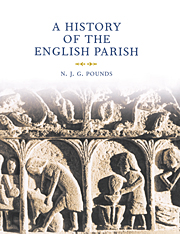Book contents
- Frontmatter
- Contents
- List of illustrations
- Preface
- List of abbreviations
- PART I THE ORIGINS OF THE PAROCHIAL SYSTEM
- PART II THE FUNCTIONS OF THE PARISH
- 5 The parish and its servants
- 6 The economics of the parish
- 7 The parish and the community
- 8 The parish and the church courts: a mirror of society
- 9 The parish church, popular culture and the Reformation
- PART III THE PARISH AND ITS CHURCH
- Notes
- Index
9 - The parish church, popular culture and the Reformation
Published online by Cambridge University Press: 29 July 2009
- Frontmatter
- Contents
- List of illustrations
- Preface
- List of abbreviations
- PART I THE ORIGINS OF THE PAROCHIAL SYSTEM
- PART II THE FUNCTIONS OF THE PARISH
- 5 The parish and its servants
- 6 The economics of the parish
- 7 The parish and the community
- 8 The parish and the church courts: a mirror of society
- 9 The parish church, popular culture and the Reformation
- PART III THE PARISH AND ITS CHURCH
- Notes
- Index
Summary
The world perception which emerges from the complex
and contradictory interaction of the reservoir of traditional
folklore and Christianity I shall call ‘medieval popular culture’.
Aaron GurevichFor Sports, for Pagentrie and Playes,
Thou hast thy Eves, and Holydayes …
Thy Wakes, thy Quintels, here thou hast,
Thy May-poles too with Garland grac't:
Thy Morris-dance, thy Whitsun-ale;
Thy Sheering-feast, which never faile,
Thy Harvest home; thy Wassaile bowle,
That's tost up after Fox i'th' Hole;
Thy Mummeries: thy Twelfe-tide Kings
And Queenes; thy Christmas revellings.
Robert HerrickThree were, it has often been said, two cultures in medieval England, that of the small and predominantly clerical élite and that of the mass of the mainly rural population. The latter had once been the culture of all the people. It was made up of their ‘values, beliefs, customs, rituals and associations’. It was traditional and it changed only very slowly. An élite culture gradually differentiated itself from the traditional. It was restricted to a small aristocratic or priestly group. It was, from an early date which varied from one society to another, both literate and leisured. It had a ‘vocabulary of sophisticated analytical terms’; it possessed notions of causality, and an appreciation of time, spatial relationships and quantities. When the Middle Ages began, the two cultures stood in opposition to one another. Elite culture strove to suppress popular; it was able to perpetuate itself through the schools, writing and, at a later date, the printed word.
- Type
- Chapter
- Information
- A History of the English ParishThe Culture of Religion from Augustine to Victoria, pp. 325 - 368Publisher: Cambridge University PressPrint publication year: 2000

